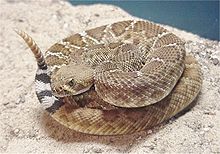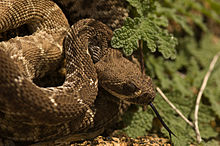- Crotalus ruber
-
Crotalus ruber 
Conservation status Scientific classification Kingdom: Animalia Phylum: Chordata Subphylum: Vertebrata Class: Reptilia Order: Squamata Suborder: Serpentes Family: Viperidae Subfamily: Crotalinae Genus: Crotalus Species: C. ruber Binomial name Crotalus ruber
Cope, 1892Synonyms - Caudisona atrox sonoraensis - Cope, 1861
- Crotalus adamanteus atrox - Cope, 1875
- Crotalus exsul - Garman, 1884
- Crotalus adamanteus ruber - Cope, 1892
- Crotalus ruber - Van Denburgh, 1896
- Crotalus atrox ruber - Stejneger, 1895
- Crotalus exsul - Grinnell & Camp, 1917
- Crotalus atrox elegans - Schmidt, 1922
- Crotalus exul ruber - Kallert, 1927
- Crotalus ruber ruber - Klauber, 1949
- Crotalus ruber elegans - Harris & Simmons, 1978
- Crotalus ruber monserratensis - Harris & Simmons, 1978
- Crotalus exsul exsul - Grismer, McGuire & Hollingsworth, 1994[1]
Crotalus ruber is a venomous pitviper species found in southwestern California in the United States and Baja California in Mexico. Three subspecies are currently recognized, including the nominate subspecies described here.[3]
Contents
Description
This is a moderately large species that commonly exceeds 100 cm on the mainland. Large males may exceed 140 cm, although specimens of over 150 cm are quite rare. The largest specimen on record measured 162 cm (Klauber, 1937).[4]
Common names
Red diamond rattlesnake, red rattlesnake, red diamond snake, red diamond-backed rattlesnake, red rattler, western diamond rattlesnake.[2] The form found on Cedros Island, previously described as C. exsul, was referred to as the Cedros Island diamond rattlesnake,[5] or Cedros Island rattlesnake.[6]
Geographic range
Found in the United States in southwestern California and southward through the Baja California peninsula, although not in the desert east of the Sierra de Juárez in northeastern Baja California. It also inhabits a number of islands in the Gulf of California, including Angel de la Guarda, Pond, San Lorenzo del Sur, San Marcos, Danzante, Monserrate and San José. Off the west coast of Baja California, it is found on Isla de Santa Margarita, which is off Baja California Sur, and (as C. exsul) on Isla de Cedros.[1]
Originally, no type locality was given, although two have been proposed: "Dulzura, San Diego County, California", by Smith and Taylor (1950), and "vicinity of San Diego, California" by Schmidt (1953).[1]
Conservation status
This species is classified as Least Concern (LC) on the IUCN Red List of Threatened Species (v3.1, 2001).[7] Species are listed as such due to their wide distribution, presumed large population, or because it is unlikely to be declining fast enough to qualify for listing in a more threatened category. The population trend is down. Year assessed: 2007.[8]
Habitat
Inhabits the cooler coastal zone, over the mountains and into the desert beyond. It prefers dense the chaparral country of the foothills, cactus patches and boulders covered with brush. Occurs from sea level to 1,500 m altitude.[9]
Feeding
Feeds on rabbits, ground squirrels and birds.[9] Wright and Wright (1957) also mention lizards and other snakes as being part of the diet of this species.[2]
Reproduction
Mating occurs between February and April. Females give birth in August, to between 3 and 20 young. Neonates are 30 to 34 cm in length.[9]
Venom
Wright and Wright (1957) state that this species is of a mild disposition and has one of the least potent rattlesnake venoms, saying that they believe it does not come into snakebite statistics as do its relatives C. atrox and C. adamanteus.[2]
Brown (1973) lists an average venom yield of 364 mg (dried) and LD50 values of 4.0, 3.7 mg/kg IV, 6.0, 7.0, 6.7 mg/kg IP and 21.2 mg/kg SC for toxicity.[10]
However, Norris (2004) warns that this species has a relatively large venom yield containing high levels of proteolytic enzymes, especially in the adults. A publication he mentions by Rael et al. (1986) showed that there are at least three proteolytic hemorrhagins that degrade fibrinogen and cause myonecrosis, but no Mojave toxin. On the other hand, three specimens from Mexico studied by Glen et al. (1983) did have Mojave toxin and lacked hemorrhagic activity.[11]
Bite symptoms include massive tissue swelling, pain, ecchymosis, hemorrhagic blebs, and necrosis. Systemic symptoms may include nausea, vomiting, coagulopathy, clinical bleeding and hemolysis.[11]
Subspecies
Subspecies[3] Taxon author[3] Common name Geographic range[1] C. r. exsul[4] Garman, 1884[4] Cedros Island diamond rattlesnake Mexico, Cedros Island.[5] C. r. lorenzoensis Radcliff & Maslin, 1975 San Lorenzo Island rattlesnake Mexico, San Lorenzo Island in the Gulf of California. C. r. lucasensis Van Denburgh, 1920 San Lucan diamond rattlesnake Mexico, cape region of lower Baja California. C. r. ruber Cope, 1892 Red diamond rattlesnake The United States in southwestern California and Mexico in Baja California, except for the cape region of lower Baja California. Taxonomy
A study by Murphy et al. (1995) concluded that there was not enough genetic and morphological diversity between C. exsul from Cedros Island and C. ruber from the mainland to warrant the recognition of both species. Since C. exsul Garman (1884) has priority over C. ruber Cope (1892), they suggested that the island population be referred to as C. e. exsul and those from the mainland as C. e. ruber. In response to this, Smith et al. (1998) petitioned the ICZN to validate ruber over exsul in the interest of nomenclatural stability. In 2000, the ICZN published Opinion 1960 in which they ruled that C. ruber should have precedence over C. exsul.[4]
See also
- List of crotaline species and subspecies
- Crotalus by common name
- Crotalus by taxonomic synonyms
- Crotalinae by common name
- Crotalinae by taxonomic synonyms
- Snakebite
References
- ^ a b c d McDiarmid RW, Campbell JA, Touré T. 1999. Snake Species of the World: A Taxonomic and Geographic Reference, vol. 1. Herpetologists' League. 511 pp. ISBN 1-893777-00-6 (series). ISBN 1-893777-01-4 (volume).
- ^ a b c d Wright AH, Wright AA. 1957. Handbook of Snakes. Comstock Publishing Associates. (7th printing, 1985). 1105 pp. ISBN 0-8014-0463-0.
- ^ a b c "Crotalus ruber". Integrated Taxonomic Information System. http://www.itis.gov/servlet/SingleRpt/SingleRpt?search_topic=TSN&search_value=174316. Retrieved 7 February 2007.
- ^ a b c d Campbell JA, Lamar WW. 2004. The Venomous Reptiles of the Western Hemisphere. Comstock Publishing Associates, Ithaca and London. 870 pp. 1500 plates. ISBN 0-8014-4141-2.
- ^ a b Klauber LM. 1997. Rattlesnakes: Their Habitats, Life Histories, and Influence on Mankind. Second Edition. First published in 1956, 1972. University of California Press, Berkeley. ISBN 0-520-21056-5.
- ^ Ditmars RL. 1933. Reptiles of the World. Revised Edition. The MacMillan Company. 329 pp. 89 plates.
- ^ Crotalus ruber at the IUCN Red List. Accessed 13 September 2007.
- ^ 2001 Categories & Criteria (version 3.1) at the IUCN Red List. Accessed 13 September 2007.
- ^ a b c Behler JL, King FW. 1979. The Audubon Society Field Guide to North American Reptiles and Amphibians. New York: Alfred A. Knopf. 743 pp. LCCCN 79-2217. ISBN 0-394-50824-6.
- ^ Brown JH. 1973. Toxicology and Pharmacology of Venoms from Poisonous Snakes. Springfield, Illinois: Charles C. Thomas. 184 pp. LCCCN 73-229. ISBN 0-398-02808-7.
- ^ a b Norris R. 2004. Venom Poisoning in North American Reptiles. In Campbell JA, Lamar WW. 2004. The Venomous Reptiles of the Western Hemisphere. Comstock Publishing Associates, Ithaca and London. 870 pp. 1500 plates. ISBN 0-8014-4141-2.
Further reading
- Cope ED. 1892. A critical review of the characters and variations of the snakes of North America. Proceedings of the U.S. National Museum 14(882): 589-694.
- Garman S. 1884. The reptiles and batrachians of North America. Memoires of the Museum of Comparative Zoology 8(3): 1-185.
- Murphy RW, Kovac V, Haddrath O, Oliver GS, Fishbein A. 1995. MtDNA gene sequence, allozyme, and morphological uniformity among red diamond rattlesnakes, Crotalus ruber and Crotalus exsul. Canadian Journal of Zoology 73(2): 270-281.
- Smith HM, Brown LE, Chiszar D, Grismer LL, Allen GS, Fishbein A, Hollingsworth BD, McGuire JA, Wallach V, Strimple P, Liner EA. 1998. Crotalus ruber Cope, 1892 (Reptilia, Serpentes): proposed precedence of the specific name over that of Crotalus exsul Garman, 1884. Bulletin of Zoological Nomenclature 55(4): 229-232.
External links
- Crotalus ruber at the Reptarium.cz Reptile Database. Accessed 12 December 2007.
- Crotalus exsul (=Crotalus ruber) Red Diamond Rattlesnake at San Diego Museum of Natural History. Accessed 7 February 2007.
Categories:- IUCN Red List least concern species
- Crotalus
Wikimedia Foundation. 2010.



